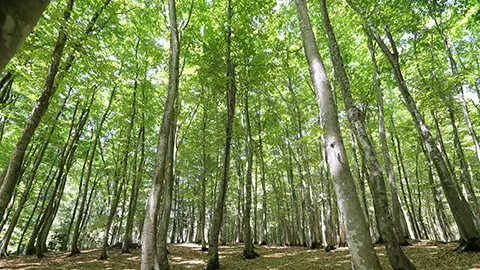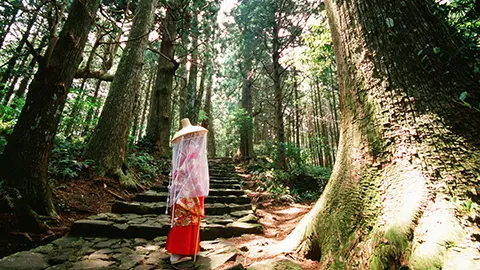VOL.192 MAY 2024
JAPAN’S HEALING FORESTS (PART 1)
The Birthplace of Shinrin-Yoku — A Cypress Forest with Trees Over 300 Years Old
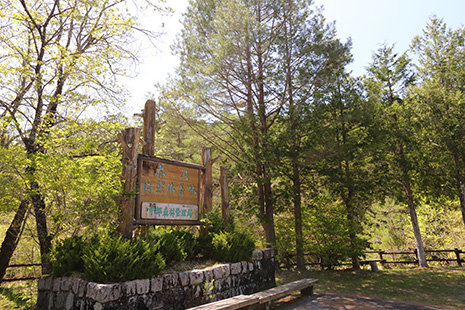
The entrance to the Akasawa Natural Recreation Forest located in Agematsu Town in southwestern Nagano Prefecture Photo: Ishizawa Yoji
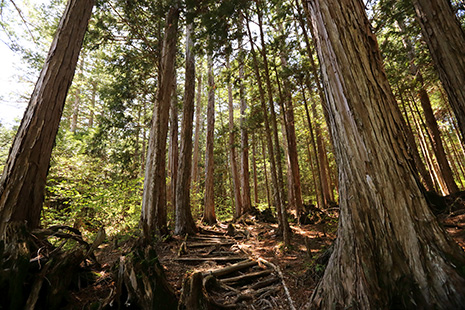
A fragrant forest of native Kiso cypress
Photo: Ishizawa Yoji
Nagano Prefecture is located roughly in the center on Japan’s main island of Honshu. The Akasawa Natural Recreation Forest,* which stretches across Agematsu Town in the southwestern part of the prefecture, has been preserved under a forest protection policy** for the past approximately 400 years. Here, we introduce this healing forest, which is considered the birthplace of the practice of shinrin-yoku, or forest bathing.
Located at an elevation of over 1,080 meters above sea level, the Akasawa Natural Recreation Forest is a coniferous forest of approximately 760 hectares, composed mainly of native Kiso cypress*** trees over 300 years old. Tatsuno Nao, a staff member of the Agematsu Town Tourism Association gave us an overview of the forest.
“The Akasawa Natural Recreation Forest was designated as Japan’s first recreation forest in 1970, and hosted the first shinrin-yoku (forest bathing) event in Japan in 1982, gaining a name for itself as the birthplace of the practice of forest bathing. The forest of Japanese cypress trees, with its refreshing scent, was selected as one of Japan’s 100 Most Fragrant Landscapes by the Ministry of the Environment.”
Near the entrance to the forest, there are various facilities where visitors can obtain information and enjoy refreshments, such as the Akasawa Forest Information Center, the Seseragi-no-Sato Akasawa Restaurant, the Forest Museum, and the Forest Railway Memorial Museum. Furthermore, seven walking courses extend from there, and visitors can combine them to make a round trip.
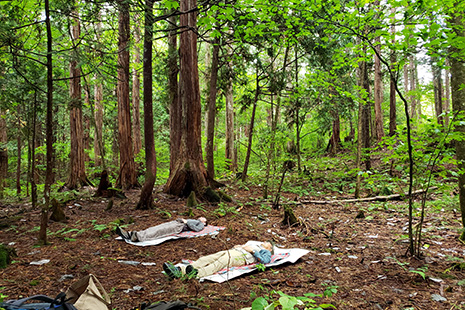
Visitors enjoying forest bathing
Photo: Agematsu Town Tourism Association
“Spending time in the woods has been scientifically proven to strengthen the immune system and relax the body and mind. The Akasawa Natural Recreation Forest hiking courses are also known as ‘therapy roads,’ and the aromatic compounds found in abundance in the forest are recognized for their health-promoting, preventive, and restorative effects. One of our highlights is that we offer walking menus and events in partnership with Nagano Prefectural Kiso Hospital.”
We asked Tatsuno to share her recommendations for spending time in the woods.
“The Komadori (Robin) Course is the typical course. It is about 1.3 km long and passes through a scenery that is distinctive of Akasawa, giving a sense of the local nature and history. The course will take you to the Ise Shrine Goshinboku Felling Site, which is the home of goshinboku,**** the sacred trees used as timber in the repeated ceremonial rebuilding of the Ise Jingu Shrine,***** and the Dondonfuchi mountain stream rest area. The giant Japanese cypress and the giant Sawara cypress at Sawarakubo along the course are the two largest trees in the park, so I highly recommend visitors to see them.”
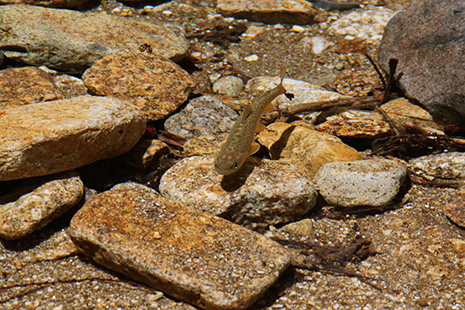
Fish can be seen swimming in the crystal clear mountain streams in the park. Photo: Ishizawa Yoji
Another recommendation is the Fureai (Friendship) Road, an accessible road that allows visitors in wheelchairs and with strollers to explore the area. Visitors can enjoy the refreshing scent of cypress, the coolness of the nearby mountain stream in summer, and the colorful foliage in fall. In addition, several facilities that were used in the days when forestry was flourishing are still in use for sightseeing. Among them, the Akasawa Forest Railway, which was used to transport timber and local residents, now operates as a sightseeing railway, giving visitors the opportunity to relax and enjoy the natural beauty of the park from the windows of the train.
The Akasawa Natural Recreation Forest is open until the beginning of November every year. If you have a chance, would you come and spend some relaxing time immersed in the serenity of nature here?
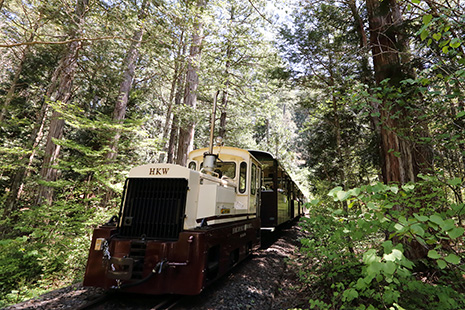
The Akasawa Forest Railway, now operated as a sightseeing railway
Photo: Ishizawa Yoji
* Natural recreation forests are forests that are particularly scenic and suitable for forest recreation activities such as forest bathing and hiking.
** The rulers of the Owari Domain, who administered the area at the time, instituted a forest protection policy in the mid-17th century and worked to restore the forests that had been devastated by logging.
*** In Japan, natural cypress trees can be found in abundance in the Kiso region of Nagano Prefecture and the Tono region of Gifu Prefecture. The natural cypress wood material produced in these regions is called “Kiso Cypress.” Its characteristic feature is the dense annual rings.
**** The ceremonial rebuilding of the Ise Jingu Shrine (Shikinen Sengu) is a more than 1,300-year-old ritual performed once every 20 years, in which the divine palace (shaden) is rebuilt on one of two sacred sites (miyadokoro) that are adjacent to each other in an east-west direction and are used alternately. The sacred vestments, furnishings, and divine treasures to be placed in the divine palace are also remade before the deity enters the new shrine. The trees used to make the vessels in which the spirit of the deity is enshrined are called goshinboku (sacred trees).
***** Located in Ise City, Mie Prefecture, it is the center of all Shinto shrines in Japan. The Ise Jingu complex consists of 125 shrines, including Kotaijingu (Naiku or Inner Shrine), dedicated to Amaterasu-Omikami, the ancestral Shinto deity of the Imperial family, and Toyo’ukedaijingu (Geku or Outer Shrine), dedicated to Toyo’uke-no-Omikami, the guardian deity of clothing, food, shelter, and other industries.
By Morohashi Kumiko
Photo: Agematsu Town Tourism Association; Ishizawa Yoji
